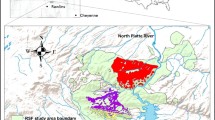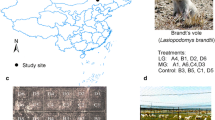Abstract
We measured population abundance and density of Dall’s sheep (Ovis dalli) before and during gray wolf (Canis lupus) and coyote (Canis latrans) harvest for 3 years (1998–2000) on two similar and adjacent study sites with treatment (canid harvests) and reference (no canid harvest) in interior Alaska, USA. Between 1998 and 1999, density of Dall’s sheep in the treatment area increased by 0.746 ± 0.163 sheep/km2. Between 1999 and 2000, after a winter with above-normal, crusted snow, density of sheep decreased by 2.1 ± 0.14 sheep/km2. Because of this large decline, sheep density on the treatment area decreased by 1.3 ± 0.08 sheep/km2 over the entire monitoring period. Sheep in the reference area showed no significant change in density between 1998 and 2000. We hypothesize that Dall’s sheep in the treatment area initially benefited from the harvest of wolves and coyotes via reduced predation and predation risk and that resultant high sheep densities coupled with severe winter weather caused a dramatic decline in Dall’s sheep between 1999 and 2000. Thus, this study illustrates the potential consequences of interactions between density-dependent and density-independent factors for the conservation of large mammals, especially those residing at high latitudes and altitudes. These results should serve as a cautionary tale for those wishing to increase ungulate numbers via predator control without regard to other ecological factors, such as the proximity of the prey population to ecological carrying capacity (K).


Similar content being viewed by others
References
Aho K (2014) Foundational and applied statistics for biologists using R. CRC/Taylor and Francis, Boca Raton
Arthur SM, Prugh LR (2010) Predator-mediated indirect effects of snowshoe hares on Dall’s sheep in Alaska. J Wildl Manag 74:1709–1721
Ballard WB, Larsen DG (1987) Implications of predator-prey relationships to moose management. Swedish Wildl Res – Viltrevy Suppl 1 Part 2:581–602
Ballard WB, Ayres LA, Krausman PR, Reed DJ, Fancy SG (1997) Ecology of wolves in relation to a migratory caribou herd in northwest Alaska. Wildl Monogr 135:1–47
Barichello N, Carey J (1988) The effect of wolf reduction on Dall sheep demography in the southwest Yukon. In: Samuel WM (ed) Northern Wild Sheep and Goat Council 6th Proc Biennial Symp. Banff, Alberta, p 307
Barten N, Bowyer RT, Jenkins KJ (2001) Habitat use by female caribou: tradeoffs associated with parturition. J Wildl Manag 65:77–92
Boertje RD, Valkenburg P, McNay ME (1996) Increases in moose, caribou and wolves following wolf control in Alaska. J Wildl Manag 60(3):474–489
Boertje RD, Keech MA, Young DD, Kellie KA, Seaton CT (2009) Managing for elevated yield of moose in interior Alaska. J Wildl Manag 73:314–327
Boertje RD, Keech MA, Paragi TF (2010) Science and values influencing predator control for Alaska moose management. J Wildl Manage 74:917–928
Bowyer RT, Leslie DM Jr (1992) Ovis dalli. Mammal Sp 393:1–7
Bowyer RT, Jr Leslie DM, Rachlow JL (2000) Dall’s and Stone’s Sheep. In: Krausman PR (ed) DemaraisS. Ecology and Management of Large Mammals in North America. Prentice Hall, Upper Saddle River, pp 491–544
Bowyer RT, Person DK, Pierce BM (2005) Detecting top-down versus bottom-up regulation of ungulates by large carnivores: implications for conservation of biodiversity. In: Ray JC, Redford KH, Steneck RS, Berger J (eds) Large carnivores and the conservation of biodiversity. Island Press, Washington, DC, pp 342–361
Bowyer RT, Kie JG, Person DK, Monteith KL (2013) Metrics of predation: perils of predator-prey ratios. Acta Theriol 58:329–340
Brown JS, Laundre JW, Gurung M (1999) The ecology of fear: optimal foraging, game theory and trophic interactions. J Mammal 80(2):385–399
Buckland ST, Anderson DR, Burnham KP, Laake JL (1993) Distance sampling: estimating abundance of biological populations. Chapman and Hall, London, p 446
Bunnell F (1978) Horn growth and population quality in Dall sheep. J Wildl Manag 42:764–775
Chisana Caribou Herd Working Group (2012) Management Plan for the Chisana Caribou Herd: 2010–2015. Gov Yukon, Dept Environ, Whitehorse, Yukon
Cohen JA (1978) Cuon alpinus. Mammal Sp 100:1–3
Coulson T, Catchpole EA, Albon SD, Morgan BJT, Pemberton JM, Clutton-Brock TH, Crawley MJ, Grenfell BT (2001) Age, sex, density, winter weather and population crashes in Soay sheep. Science 292:1528–1531
Creel S, Christianson D (2008) Relationships between direct predation and risk effects. Trends Ecol Evol 23:194–201
Dale BW, Adams LG, Bowyer RT (1995) Winter wolf predation in a multiple ungulate prey system, Gates of the Arctic National Park, Alaska. In: Carbyn LN, Fritts SH, Seip DR (eds.) Ecology and conservation of wolves in a changing world. Can Circumpolar Inst, Occ Pub 35:223–230
Eberhardt LL, White PJ, Garrott RA, Houston DB (2007) A seventy year history of trends in Yellowstone’s Northern elk herd. J Wildl Manag 72:594–602
Errington P (1946) Predation and vertebrate populations. Quart Rev Biology 21(144–177):221–245
Farnell R, Gardner CL (2003) Status of the Chisana Caribou Herd 2002. Yukon Fish and Wildlife Branch, Whitehorse, pp 1–24
Fedosanko VA, Blank DK (2005) Ovis ammon. Mammal Sp 773:1–15
Fuller TK, Mech LD, Cochrane JF (2003) Wolf population dynamics. In: Mech LD, Boitani L (eds) Wolves: behavior ecology and conservation. Univiversity of Chicago Press, Chicago, pp 161–191
Gallant AL, Binnian EF, Omernik J, Shasby M (1995) Ecoregions of Alaska. US Geological Survey Professional Paper 1567, Alaska p 73
Gasaway WC, Stephenson RO, Davis JL, Shepherd PEK, Burris OE (1983) Interrelationships of wolves, prey and man in interior Alaska. Wildl Monogr 84:1–50
Gasaway WC, Boertje RD, Graangard DV, Kelleyhouse DG, Stephenson RO, Larson DG (1992) The role of predation in limiting moose populations at low densities in Alaska and Yukon and implications for conservation. Wildl Monogr 120:1–59
Harris RB (2006) Attempted predation on Blue Sheep Pseudois nayaur (Hodgson) by dholes Cuon alpinus (Pallas) in China. J Bombay Nat Hist Soc 103:95–97
Hayes RD, Farnell R, Ward RMP, Carey J, Dehn M, Kuzyk G, Baer AM, Gardner CL, O’Donoghue M (2003) Experimental reduction of wolves in the Yukon: ungulate responses and management implications. Wildl Monogr 152:1–37
Heimer WE, Stephenson RO (1982) Response of Dall sheep populations to wolf control in interior Alaska. In: Bailey JA,. Schoonveld GG (eds.) Northern Wild Sheep and Goat Council Proceedings Biennial Symposium,3:320–329
Hobson R (1972) Surface roughness in topography: quantitative approach. In: Chorley R (ed) Spatial analysis in geomorphology. British Geomorphometric Res Group, London, pp 220–245
Hoefs M (1984) Productivity and carrying capacity of a subarctic sheep range. Arctic 37:141–147
Hoefs M, Cowan IM (1979) Ecological investigation of a population of Dall sheep (Ovis dalli dalli Nelson). Syesis 12(Suppl 1):1–81
Jedrzejewska B, Jedrzejewska W (1998) Predation in Vertebrate Communities. The Bialowieza Primeval Forest as a Case Study. Ecological Studies 135, Springer-Verlag, Berlin.
Keen RA (2008) Climate data analysis of existing weather stations in and around the Central Alaska Network (CAKN). National Park Service, Central Alaska Inventory and Monitoring Network, Anchorage, Alaska
Kie JG, Bowyer RT, Stewart KM (2003) Ungulates in western forests: habitat requirements, population dynamics, and ecosystem processes. In: Zabel CJ, Anthony RG (eds) Mammal community dynamics: management and conservation in the coniferous forests of western North America. Cambridge University Press, Cambridge, pp 296–340
Knowlton FF (1972) Preliminary interpretations of coyote population mechanics with some management implications. J Wildl Manag 36:369–382
Krausman PR, Bowyer RT (2003) Mountain sheep (Ovis canadensis and O. dalli). In: Feldhamer GA, Thompson BC, Chapman JC (eds) Wild mammals of North America: biology, management, and conservation, 2nd edn. The Johns Hopkins University Press, Baltimore, Maryland, USA, pp 1095–1115
Krebs CJ, Keilland K, Bryant J, O’Donoghue M, Doyle F, McIntyre C, DeFolco D, Berg N, Carriere S, Boonstra R, Boutin S, Kenney AJ, Reid DG, Bodony K, Putera J, Timm HK, Burke T (2013) Synchrony in the snowshoe hare (Lepus americanus) cycle in northwestern North America, 1970–2012. Can J Zool 91:562–572
Kruuk H (2002) Hunter and Hunted. Cambridge University Press, Cambridge, UK
Lanszki J, Markus M, Ujvary D, Szabo A, Szemethy L (2012) Diet of wolves Canis lupus returning to Hungary. Acta Theriol 57:189–193
McCullough DR (1979) The George Reserve Deer Herd: population ecology of a K-selected species. University of Michigan Press, Ann Arbor, Michigan
Mech LD, Adams LG, Meier TJ, Burch JW, Dale B (1998) The wolves of Denali. University of Minnesota Press, Minneapolis, Minnesota
Meriggi A, Brangi A, Schenone L, Signorelli D, Milanesi P (2011) Changes of wolf (Canis lupus) diet in Italy in relation to the increase of wild ungulate abundance. Ethol Ecol Evol 23:195–210
Murie A (1944) The wolves of Mount McKinley. Fauna of the National Parks of the United States No. 5. U.S. Gov Print Off, Washington, D.C.
National Research Council (1997) Wolves, bears and their prey in Alaska: biological and social challenges in wildlife management. National Academy Press, Washington, D.C
Nichols L (1978) Dall’s sheep. In: Schmidt JL, Gilbert DL (eds) Big game of North America. Stackpole Books, Harrisburg, Pennsylvania, pp 173–198
Nichols L, Bunnell FL (1999) Natural history of thinhorn sheep. In: Valdez R, Krausman PR (eds) Mountain sheep of North America. University of Arizona Press, Tucson, pp 23–77
Ordiz A, Bischoff R, Swenson JE (2013) Saving large carnivores, but losing the apex predator? Biol Cons 168:128–133
Pierce BM, Bleich VC, Monteith KL, Bowyer RT (2012) Top-down versus bottom-up forcing: evidence from mountain lions and mule deer. J Mammal 93:977–988
Rachlow JL, Bowyer RT (1991) Interannual variation in timing and synchrony of parturition in Dall’s sheep. J Mammal 72:487–492
Rachlow JL, Bowyer RT (1994) Variability in maternal behavior by Dall’s sheep: environmental tracking or adaptive strategy? J Mammal 75:328–337
Rachlow JL, Bowyer RT (1998) Habitat selection by Dall’s sheep (Ovis dalli): maternal trade-offs. J Zool 245:457–465
R Core Team (2013) R: A language and environment for statistical computing. R Foundation for Statistical Computing, Vienna, Austria. http://www.R-project.org/
Regelin WL, Valkenburg P, Boertje RD (1995) Management of large predators in Alaska. Wildl Biol Practice 1:77–85
Roemer GR, Gompper ME, vanValkenburgh B (2009) The ecological role of the mammalian mesocarnivore. Bioscience 59:165–173
Schaller, GB (1998) Wildlife of the Tibetan Steppe. University of Chicago Press, Chicago, p 374
Scotton BD (1998) Timing and causes of neonatal Dall’s sheep mortality in the central Alaska Range. University Montana, Missoula, Montana, MSc Thesis
Seaton CT, Paragi TF, Boertje RD, Kielland K, DuBois S, Fleener CJ (2011) Browse biomass removal and nutritional condition of moose Alces alces. Wildl Biol 17:55–66
Strickland D, MacDonald LL, Taylor D, Jenkins K (1992) Estimation of Dall sheep numbers in the Wrangell-St. Elias National Park and Preserve. In: Emmerich J, Hepworth WG (eds.) Northern Wild Sheep and Goat Council Proceedings 8:237–255
Sumanik RS (1987) Wolf ecology in the Kluane Region. MSc Thesis, Michigan Technological University, Houghton, Michigan, Yukon Territory
Terwilliger MLN (2005) Population and habitat analyses for Dall’s sheep (Ovis dalli) in Wrangell-St. Elias National Park and Preserve, Alaska. MSc Thesis, University of Alaska, Fairbanks
Udevitz MS, Shults BS, Adams LG, Kleckner C (2006) Evaluation of aerial survey methods for Dall’s sheep. Wildl Soc Bull 34(3):732–740
Vucetich JA, Peterson RO (2004) The influence of top-down, bottom-up and abiotic factors on the moose (Alces alces) population of Isle Royale. Proc Royal Soc Lond B 271:183–189
Wang X, Hoffman RS (1987) Pseudois nayaur and Pseudois schaeferi. Mammal Sp 278:1–6
Young DD Jr, Boertje RD (2011) Prudent and imprudent use of antlerless moose harvests in interior Alaska. Alces 47:91–100
Young SP, Goldman EA (1944) The wolves of North America. American Wildlife Institute, Washington, D.C
Acknowledgments
We thank the US National Park Service, Wrangell-Saint Elias National Park and Preserve for funding surveys of Dall’s sheep, and especially M.L.N. Terwilliger and J. Putera for assisting with data acquisition. A.R. Henry entered GIS data. L.G. Adams and other reviewers provided critically important reviews of earlier drafts.
Author information
Authors and Affiliations
Corresponding author
Additional information
Communicated by: Marietjie Landman
Rights and permissions
About this article
Cite this article
Mitchell, C.D., Chaney, R., Aho, K. et al. Population density of Dall’s sheep in Alaska: effects of predator harvest?. Mamm Res 60, 21–28 (2015). https://doi.org/10.1007/s13364-014-0199-4
Received:
Accepted:
Published:
Issue Date:
DOI: https://doi.org/10.1007/s13364-014-0199-4




